MARIANI’S
Virtual Gourmet
February
26, 2017
NEWSLETTER

Travel
Poster by Roger Broders, 1924
IN THIS ISSUE
VIENNA, Part Two
By John Mariani
NEW YORK CORNER
LE MARAIS
By John Mariani
NOTES FROM THE WINE CELLAR
STONY HILL WINERY
MAKES WINE THE WAY THEY HAVE
FOR THREE GENERATIONS
By John Mariani
❖❖❖
DINING OUT IN VIENNA
By John Mariani

PALMENHAUS RESTAURANT
As in every city of any size
these days, Vienna is host to just about every kind
of restaurant, from Wiener Schnitzel to sushi,
although when I visit I tend to stick closer to
Austrian fare, whether traditional or done with a
contemporary flair.
Here are some of the restaurants I liked most
on my recent trip to the capital city.
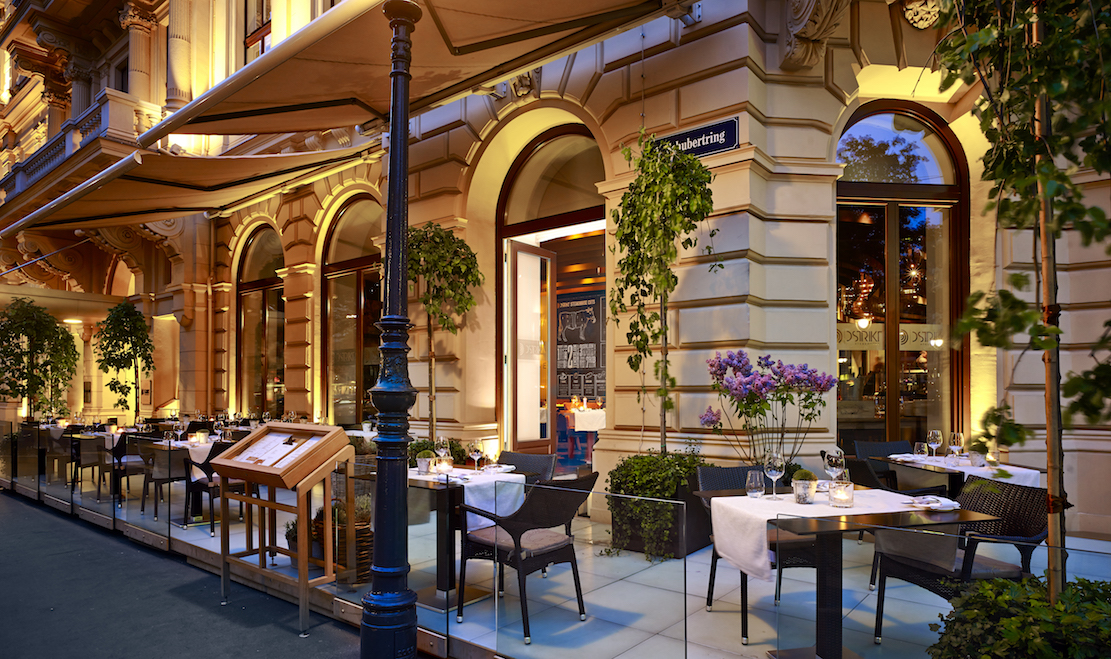 DSTRIKT
DSTRIKT
Ritz-Carlton Hotel
Schubertring 5-7
43-1-311-88
Dstrikt, in the Ritz-Carlton
Hotel, has made quite an impact in Vienna, for it
is the first restaurant to combine the American
steakhouse with an Austrian sensibility. (It
also may well be the only restaurant in Europe to
adapt the cliché “farm-to-table.”)
When spring comes, you may dine
outside and watch the passing pedestrians on the
Ringstrasse; inside you might begin with a
cocktail at the swank, upholstered D-Bar, which
stocks 40 rums, along with Viennese coffees and
beers. The
Dstrikt dining room is smartly casual, with white
walls and coffee brown floor, wine barrels and a
ceiling of swirling metal ribbons, with very
comfortable armchairs and a blackboard menu of the
Austrian meat cuts available, all cooked on a
charcoal grill.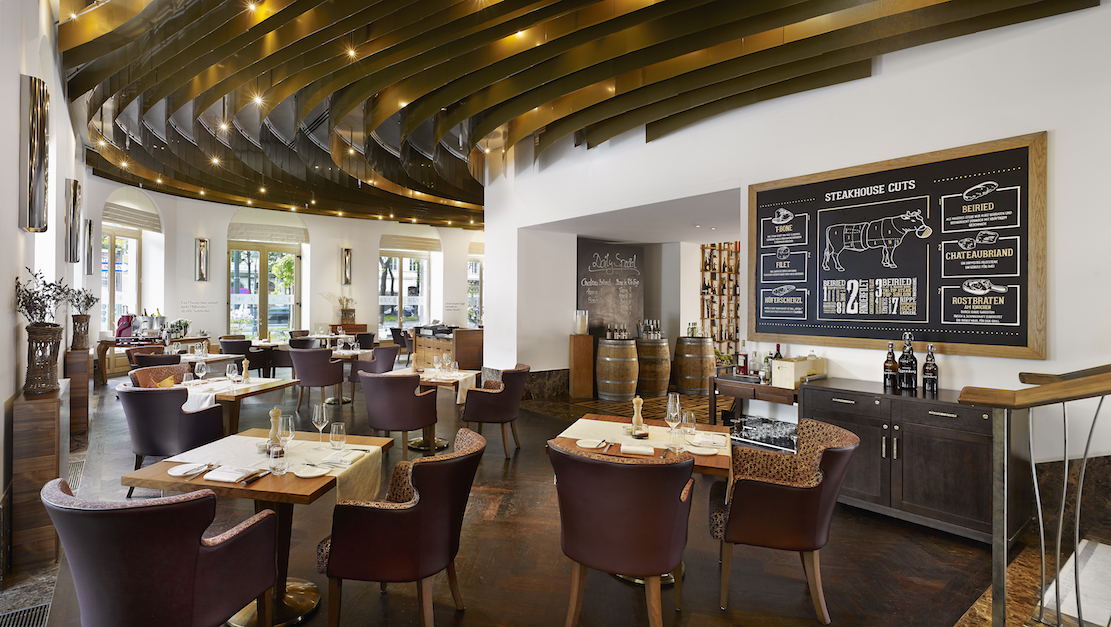 There
is a Steak Brunch on weekends.
There
is a Steak Brunch on weekends.
As everywhere in Vienna,
Dstrikt’s service staff, dressed in white chef’s
shirts, is extremely cordial in helping you with
the menu (in German and English), and the wine
list is certainly one of the finest in the city,
with scores of the best modern Austrian bottlings. You
even get a choice of eleven knives with which to
slice your steak, though I can’t imagine why.
I began my meal with a
“classic” onion soup (10€), whose broth was very
onion-rich but whose Gruyère cheese topping had
not been put under the grill long enough to give
the soup its characteristic bubbling 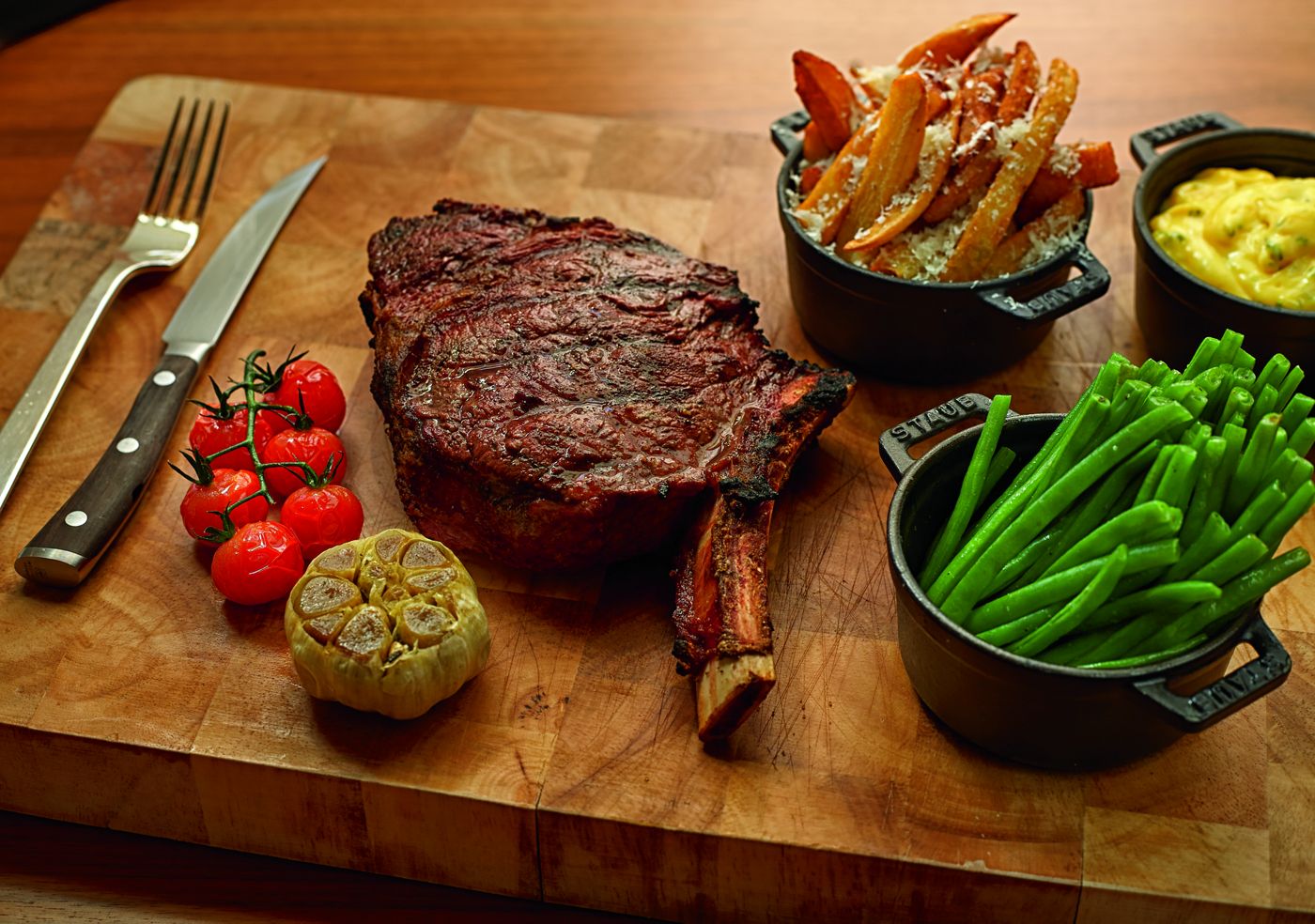 brown texture. Chopped
salad with baby gem lettuce, beets, pumpkin, green
beans, radicchio, Manchego cheese and
honey-mustard dressing (16€) was very well
rendered and could make a main course for lunch or
dinner, if you like.
brown texture. Chopped
salad with baby gem lettuce, beets, pumpkin, green
beans, radicchio, Manchego cheese and
honey-mustard dressing (16€) was very well
rendered and could make a main course for lunch or
dinner, if you like.
We
enjoyed a sampling of three cuts of meat (65€ per
person for two people), both Austrian and imported
from the U.S., all nicely aged, which is uncommon
in Europe. The ribeye was the most flavorful, the
flank steak had its characteristic chewiness and
succulence, and rack of lamb was the best of all. These
come with two side dishes; we chose truffled
French fries dusted with Parmigiano and garlicky
creamed spinach, and also indulged in some
mac-and-cheese. There is also a choice of sauces
like green pepper corn, aïoli or Béarnaise.
As one might expect in Austria,
the cheesecake (10€) is terrific (below), as
well as a pear-blackberry crumble with goat’s
cheese ice cream (9€).
You might end
the evening here at the Ritz’s Rooftop Bar  with Austrian coffee and brandy,
looking out over a city where everyone seems to be
just exiting a musical event.
with Austrian coffee and brandy,
looking out over a city where everyone seems to be
just exiting a musical event.
Open for lunch
and dinner daily, breakfast Mon.-Fri.
Photos by Tina Herzl
AMADOR’S
WURSTHAUS
& GREISSLEREI
Grinzingerstrasse 86
43-660-90-70-500
Juan Amador is one of the stars of
Austrian cuisine, with restaurants in Frankfurt
and Singapore, and his new eponymous venture is
located outside of Vienna’s city center near the
Karl Marx Hof, a vast series of subsidized
apartment buildings stretching for almost a mile
in the 19th District, now becoming quite
fashionable.
Together with vineyard owner
Fritz Wieninger, Amador has created two dining
rooms under dramatic brick archways, one a fine
dining venue (below),
the other somewhat more rustic (right),
although I found the food in the latter very
sophisticated and representative of modern
Austrian cooking.
Greisslerei
refers to a small grocer, and you can purchase
both wine and foods on the premises.
 Even at lunch, the menu
is quite extensive, ranging from a lovely,
tart-sweet cherry consommé à la Royal with quail
egg and matzo dumpling to ravioli in a lush sauce
vierge (left). Sausage
and lentils came with mashed potatoes and fried
onions, but they were lighter than you’d have
elsewhere in the city, and risotto was abundant
with translucent scallops and shrimp in a foamy
sauce.
Even at lunch, the menu
is quite extensive, ranging from a lovely,
tart-sweet cherry consommé à la Royal with quail
egg and matzo dumpling to ravioli in a lush sauce
vierge (left). Sausage
and lentils came with mashed potatoes and fried
onions, but they were lighter than you’d have
elsewhere in the city, and risotto was abundant
with translucent scallops and shrimp in a foamy
sauce.
You’ll find roast goose on many
menus in Vienna, but Amador’s is one of the best,
most carefully cooked I’ve ever had, with sweet
glazed chestnuts, sour cherry-brined red cabbage
and bread dumplings lavished with a fresh apple
sauce. The
desserts, as you expect in Austria, 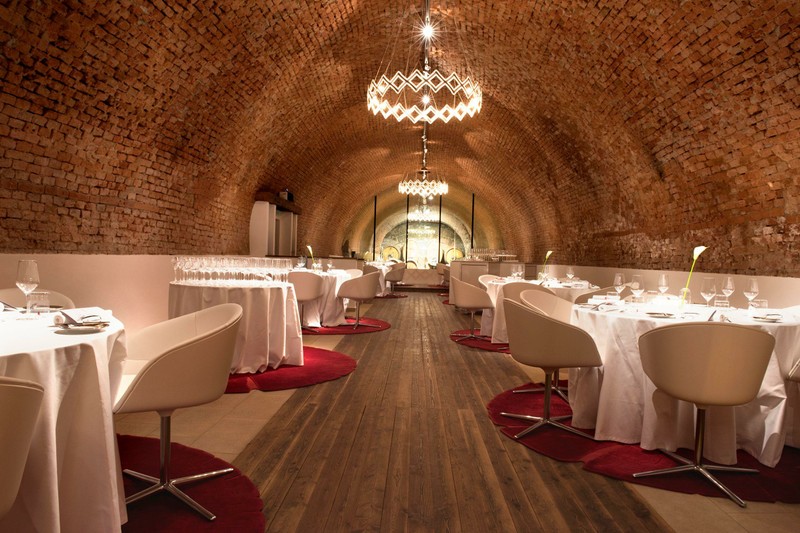 are beautifully crafted,
especially those made with chocolate or seasonal
fruits.
are beautifully crafted,
especially those made with chocolate or seasonal
fruits.
There is a 3-course meal at
55€; otherwise, à la carte dishes run 4.50€ to 16€
for first courses and 18€ to 24€ for main courses.
If you
want to see the new direction of Austrian cuisine,
Amador’s is worth the drive out to the 19th
District.
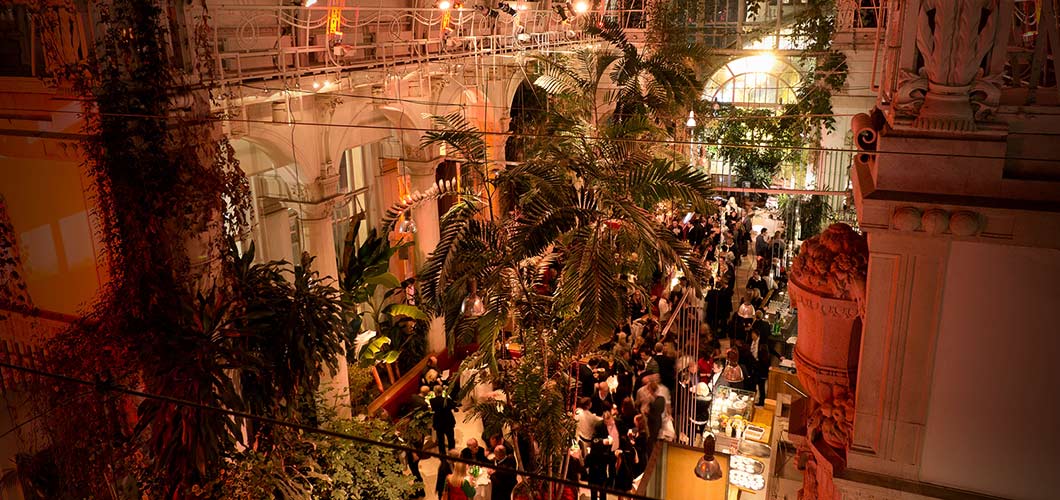 PALMENHAUS
CAFÉ
RESTAURANT
PALMENHAUS
CAFÉ
RESTAURANT
43-1-533-1033-13
What a splendid place this!
Set within a long greenhouse dating to 1822 within
the Hofburg Palace Gardens and re-designed in 1901
by architect Friedrich Ohman, who brought in huge
palm trees, the restaurant actually saved the
structure from the decrepitude into which it had
fallen by 1988, when it was closed to the public
for ten years.
 After
an investment of $17 million, it is now one of the
most beautiful buildings of its kind in the world,
complete with a butterfly house. You can
imagine it is very popular as an event venue (above).
After
an investment of $17 million, it is now one of the
most beautiful buildings of its kind in the world,
complete with a butterfly house. You can
imagine it is very popular as an event venue (above).
The staff is young, both on the
service side and in the huge open kitchen, and the
food is a mix of Austrian and international fare,
which, in the spirit of things here, offers a kind
of open-ended menu. You can have just a bowl of
carrot soup (5.80€) or jalapeño-riddled meat loaf
(12.80€) or a larger meal of a mixed grill
(23.50€) of lake and sea fish (right), all
of which are impeccably cooked. Sandwiches are
hefty and served on a baguette; we loved the
spicy sausage, peppers and sauerkraut (left).
The menu changes all the time,
so when young herring is in season they serve it
with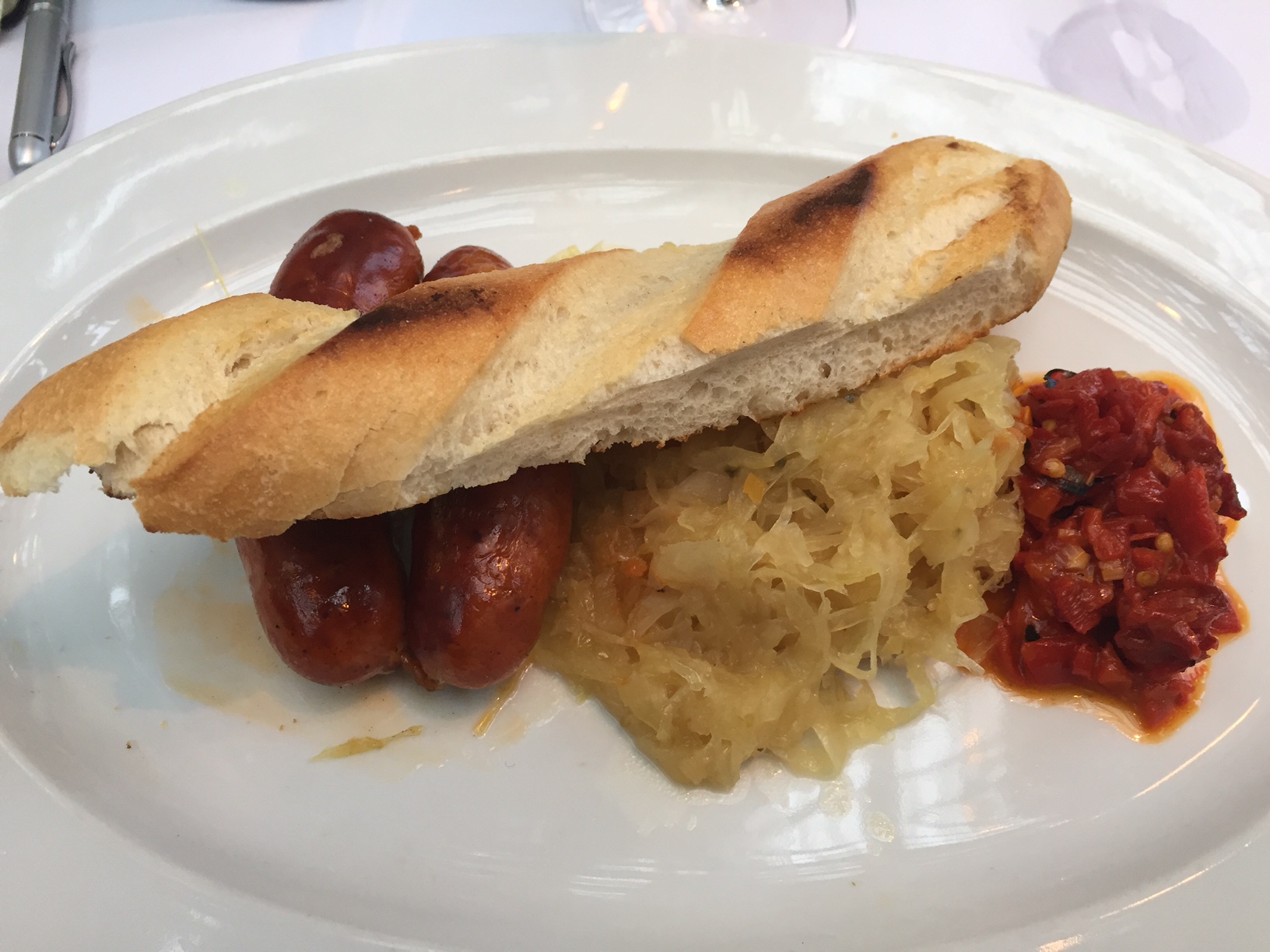 red onion,
apple-sour cream and buttered pumpernickel
(14.10€), and for desserts they’ll bring in exotic
fruit like mangolassi with a blood orange sorbet
(9.20€).
red onion,
apple-sour cream and buttered pumpernickel
(14.10€), and for desserts they’ll bring in exotic
fruit like mangolassi with a blood orange sorbet
(9.20€).
There’s a wine list adequate
for this kind of big bistro, and plenty of beers
to choose from.
I was at
Palmenhaus in early winter, when its warm interior
was a balm after a long cold walk through the
streets of Vienna.
I can only imagine how beautiful it must be
in the other seasons, when the gardens are in full
flourish.
RESTAURANT
GRAND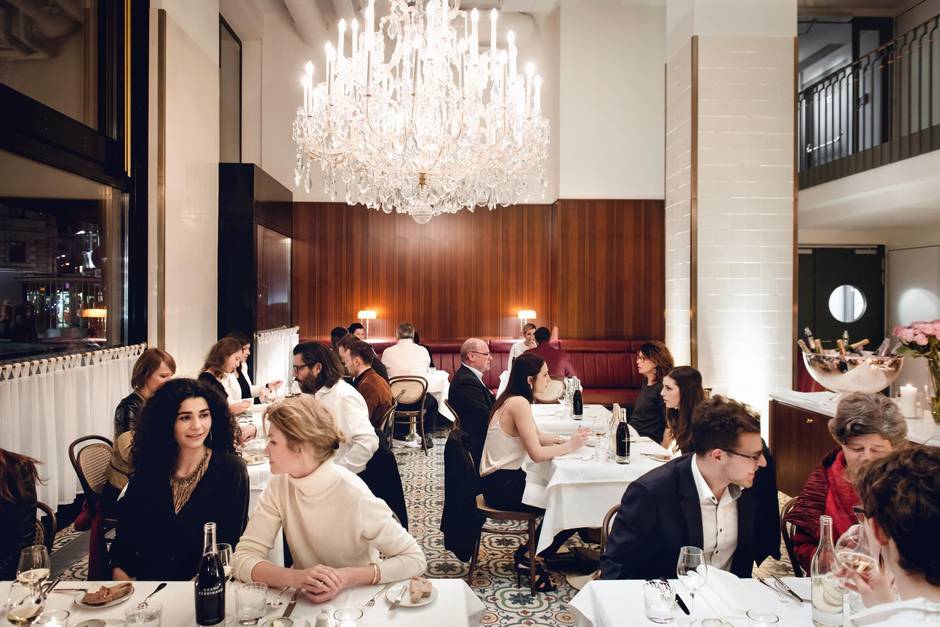
FERDINAND AM RING
Hotel Grand Ferdinand
Schubertring 10-12
Just a few doors down from the
Ritz-Carlton is the Hotel Grand Ferdinand, whose
restaurant of the same name hearkens back to the
sumptuous cuisine of the Hapsburg Empire,
including, of course, Wiener Schnitzel
and—presented with great flourish the way it used
to be—tafelspitz,
the famous boiled beef dish that here is wheeled
out on a silver cart and ceremoniously carved and
plated tableside (below). From
that steaming cart comes generous slices of
shoulder, leg, tongue and marrow bones with a
ladle of restorative broth, served with creamed
spinach, lettuce with peas, pan-fried potatoes,
apple horseradish and horseradish chive sauce at a
remarkable 26€.
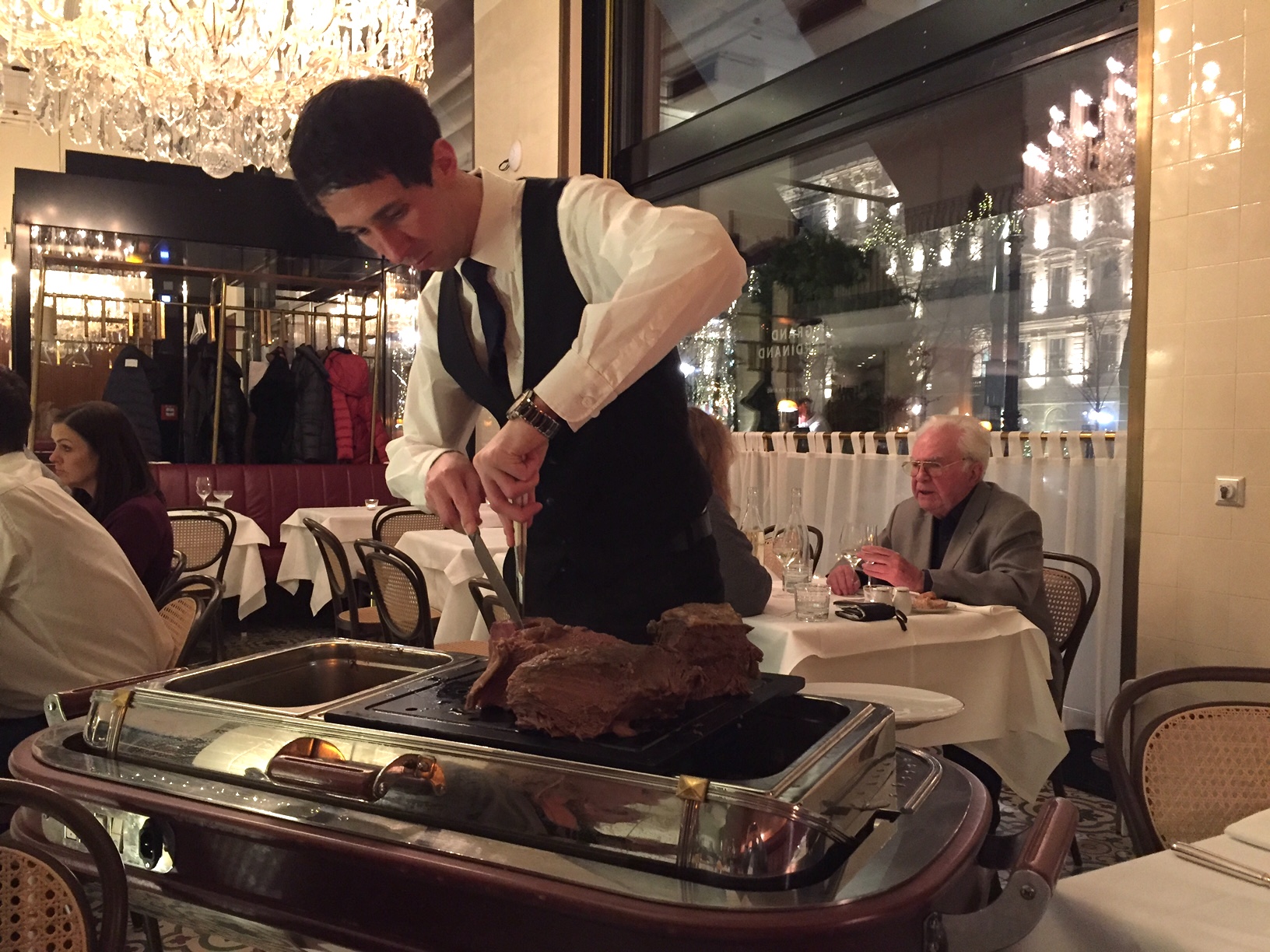 Before
that, consider the cured salmon with marinated
cucumber (14€) or the delicious Kaisersuppe
(8€), a hearty veal soup with sweetbreads and
morsels of tongue.
One of the other classics on the menu is
“minced meat fritters à la Metternich,” with
spinach and poached egg (€24), said to made
according to an original 1814 recipe and named
after a Prince Metternich, who, to judge by this
example, must’ve had fairly bland
taste.
Before
that, consider the cured salmon with marinated
cucumber (14€) or the delicious Kaisersuppe
(8€), a hearty veal soup with sweetbreads and
morsels of tongue.
One of the other classics on the menu is
“minced meat fritters à la Metternich,” with
spinach and poached egg (€24), said to made
according to an original 1814 recipe and named
after a Prince Metternich, who, to judge by this
example, must’ve had fairly bland
taste.
You may follow the main course
with a selection of sweets that include sweet
ravioli called powidltascherl,
chocolate cake (below)
and a dessert called “Wiener
Waschermadl” (14€), meaning Viennese
washerwoman, perhaps because the pastry is twisted
like laundry.
Kaiserschmarn
is a fine dessert made of cut-up caramelized
pancakes (12€).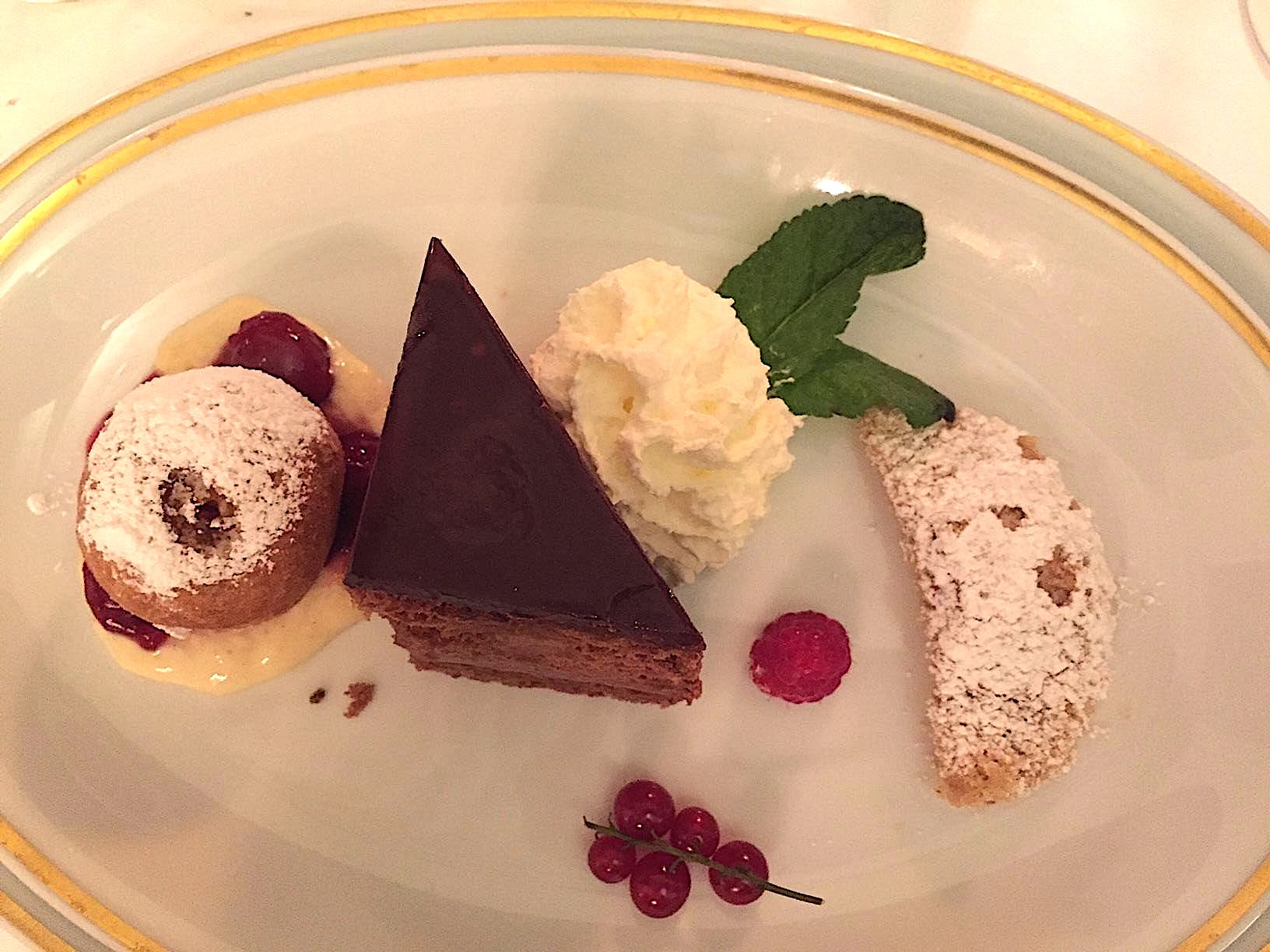
On Ash
Wednesday (March 1) the restaurant will hold an
Old Viennese “Heringsschamus”
of seafood dishes like pike dumplings with dill
cream and carp soup.
The wine list is not extensive
but the selections, from Eastern and Western
Europe, are admirable, with a good number of
brandies, and the prices are reasonable.
The
dining room has enormous warmth and charm, well
lighted by shimmering chandeliers, with double
white tablecloths, café curtains, patterned tile
floors and bentwood bistro chairs. You feel very
much that you are a part of what is old and what
is new in Vienna gastronomy right now.
 HUTH
GASTWIRTSCHAFT
HUTH
GASTWIRTSCHAFT
Schnellinggasse 5
43-1-513-56-44
Once seated in the two-story
dining room, you’ll find the atmosphere is
casually sophisticated and very friendly, and if
you can engage the sober-faced proprietor in
conversation, he may warm to you and tell you that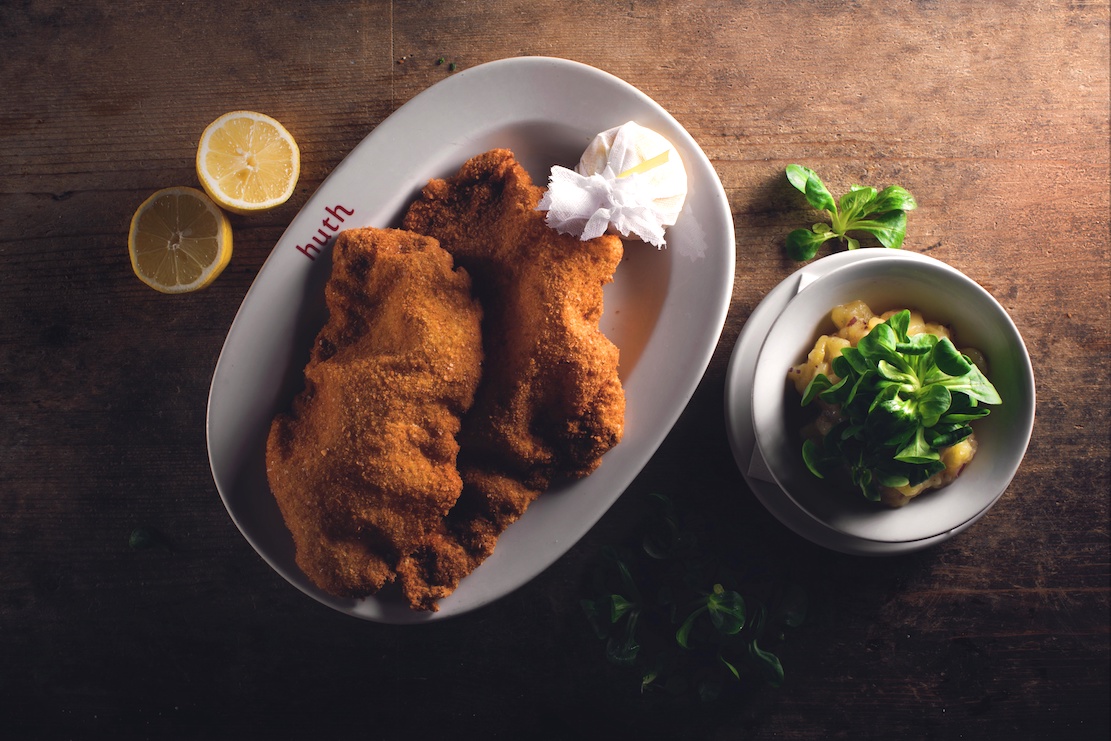 his is
the “original Wiener Schnitzel,” which is
difficult to believe since the dish is the
national dish of Austria and originated in the
middle of the 19th century. I’m
sure Huth means his is made according to the
original recipe, alleged to have been brought back
from Italy by Field Marshal von Radetz in
1857, but without any real historical evidence.
his is
the “original Wiener Schnitzel,” which is
difficult to believe since the dish is the
national dish of Austria and originated in the
middle of the 19th century. I’m
sure Huth means his is made according to the
original recipe, alleged to have been brought back
from Italy by Field Marshal von Radetz in
1857, but without any real historical evidence.
In any case,
Huth’s deep-fried Schnitzel (18.90€) is excellent,
impeccably crispy, not at all greasy, served with
a nice green salad. Before that, have the very
good light chestnut soup, or the plump potato
ravioli in a thick dough dressed with fine butter
(8.90€ as a starter, or 13.90€ as a main).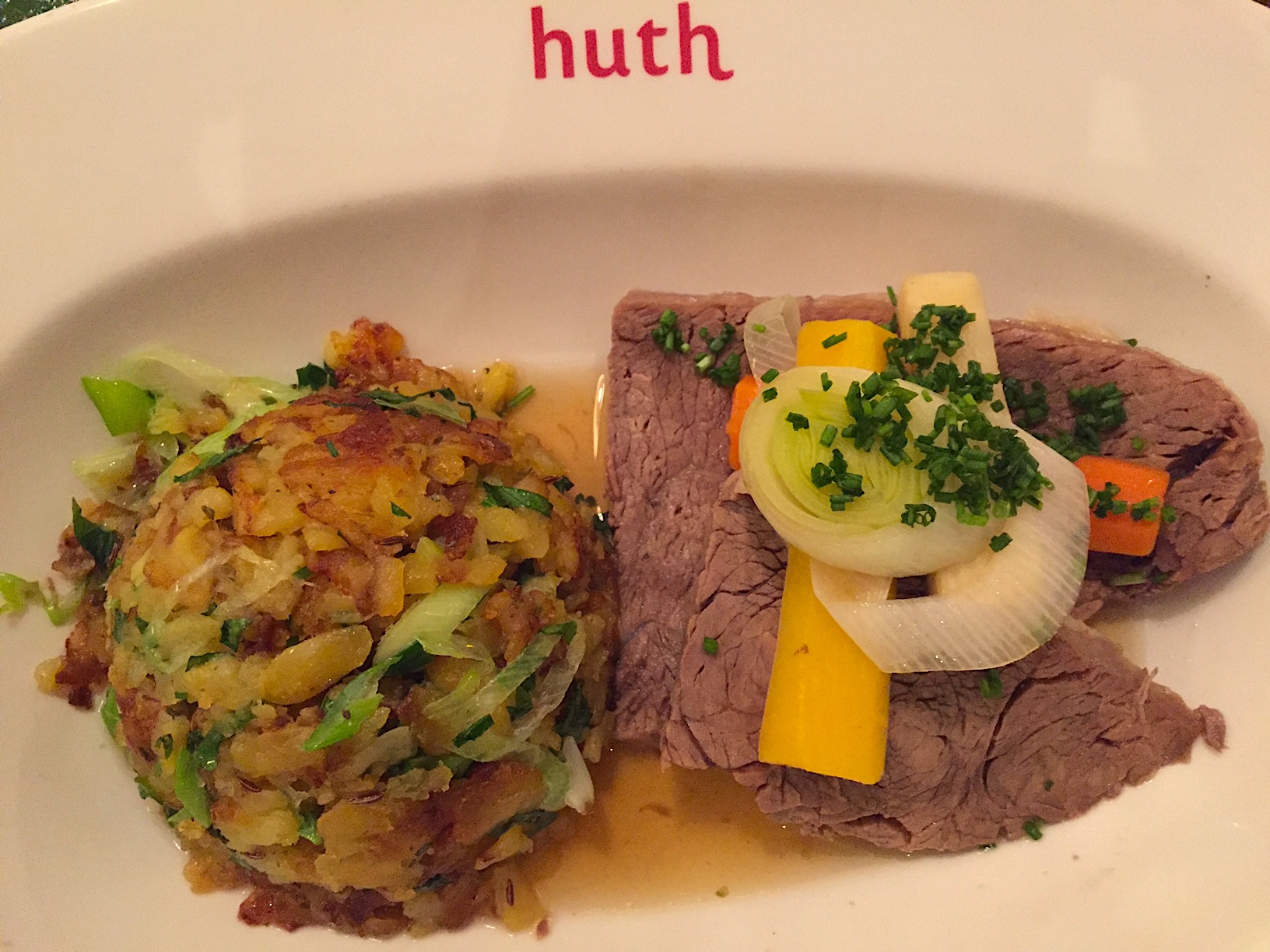 At Huth
the tafelspitz
(19.90€) is served without broth (left)—“That’s
what they do at Plachutta!” snapped Huth,
referring to a well known restaurant in town whose
specialty is tafelspitz.
At Huth
the tafelspitz
(19.90€) is served without broth (left)—“That’s
what they do at Plachutta!” snapped Huth,
referring to a well known restaurant in town whose
specialty is tafelspitz.
For dessert one can
hardly avoid having the comforting apple strudel
(5.80€).
Herr
Huth is a character, all right, but
I rather enjoyed dining there, not despite his
demeanor but because of it. Jolliness
can take different forms, and for food this good,
it’s worth the character study.
Open daily for
lunch and dinner.
A
FEW WORDS ABOUT DINING IN VIENNA
* Just
about every restaurant has a menu in
English.
* Dress, as everywhere in Europe these days, is
casual, but at the more traditional
restaurants and cafés you will want to dress a bit
conservatively, although bluejeans are everywhere.
* There is no smoking allowed inside.
* Service is unfailingly courteous, and in the
cafés very efficient; you won't wait more than a
minute or two for your order.
* As for tipping, I received various answers from
various Austrian friends. Many restaurants
still list an old-fashioned cover charge, which
can be a hefty €2-4, along with the standard
10 percent value added tax. A
reasonable gratuity is 10-15 percent of the bill,
before the tax.
❖❖❖
By John Mariani
Le Marais
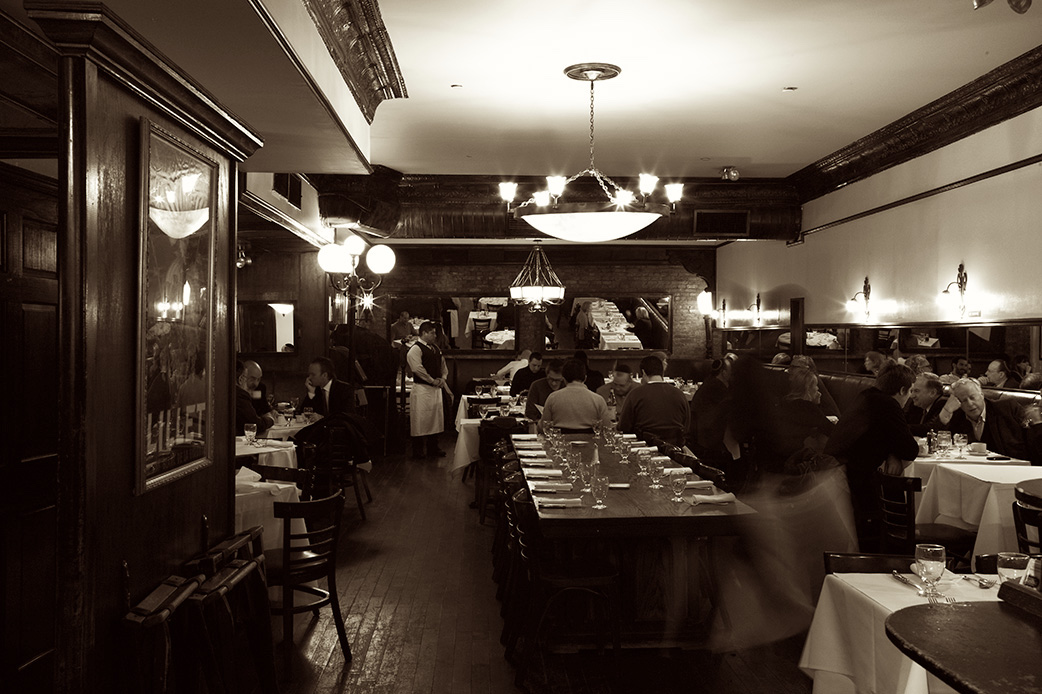
150 West 46th Street (Between 6th and 7th Aves.)
212-869-0900
After
saying that Le Marais is a kosher steakhouse and
noting that it serves no dairy products or
shellfish and must close on Friday evenings and
Saturdays, I have said all I need to about its
differences from a non-kosher steakhouse. And
that was the guiding principle when a non-Jewish
Portuguese named José Meirelles took the advice of
his lawyers to open a kosher steakhouse (he was
already partner at the non-kosher Les Halles
bistro). After
first sourcing some of the finest beef available,
Meirelles went out and hired an Irish-American
chef named Mark Hennessey. What could
go wrong?
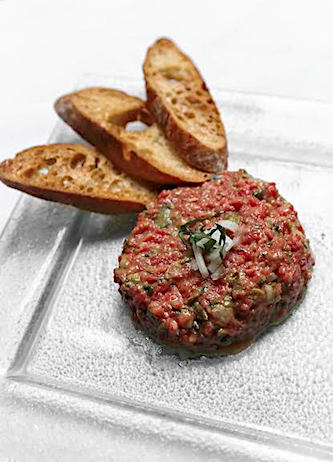 Remarkably, nothing did,
and over the past two decades Le Marais, which is
named after a Jewish neighborhood in Paris, has
distinguished itself as among NYC’s best
steakhouses, if you don’t mind missing shrimp
cocktail and cheesecake made with cheese. Meirelles
and Hennessey honed their own way of cooking their
meat, both grain- and grass-fed, giving its
exterior a magnificent charring while keeping the
interior extremely juicy. most of all a “La Surprise” cut
($50), which begins as a massive ribeye with its
cap removed, making it a kind of filet mignon; the
cap is then grilled till succulent as a steak. More important, their dry-aging
process gives the beef a richness of mineral
flavors without a hint of sourness you get from
wet aging. As
Hennessey is fond of repeating, “When
your mom comes in and asks if our meat is fresh,
we proudly say ‘no.’”
Remarkably, nothing did,
and over the past two decades Le Marais, which is
named after a Jewish neighborhood in Paris, has
distinguished itself as among NYC’s best
steakhouses, if you don’t mind missing shrimp
cocktail and cheesecake made with cheese. Meirelles
and Hennessey honed their own way of cooking their
meat, both grain- and grass-fed, giving its
exterior a magnificent charring while keeping the
interior extremely juicy. most of all a “La Surprise” cut
($50), which begins as a massive ribeye with its
cap removed, making it a kind of filet mignon; the
cap is then grilled till succulent as a steak. More important, their dry-aging
process gives the beef a richness of mineral
flavors without a hint of sourness you get from
wet aging. As
Hennessey is fond of repeating, “When
your mom comes in and asks if our meat is fresh,
we proudly say ‘no.’”
The restaurant is set on two
floors, past a boucherie and modest bar, both done
in dark woods, fin de siècle light fixtures,
banquettes and tilted mirrors, white tablecloths
and an undraped communal table, and, upstairs,
armchairs you will literally sink down into. The
service staff is very cordial indeed and quick on
their feet.
You won’t wait long for your food.
The menu is quite a bit longer
than the average steakhouse’s, despite a lack of
shellfish. Cured
and smoked “bacon” is made from veal ($18). The
creamy, delicious rillettes are made from duck and
veal ($12), and the two fish offered, seemingly
an afterthought, are fillet of roast salmon with
ratatouille ($30) and pan-fried flounder with
Israeli couscous and tomato-cucumber salsa ($29).
I delighted
in a large, easy-to-share frisée salad of smoked
duck confit ($38), refreshingly crisp and the duck
meat so tender.
Rare, sesame-crusted tuna with chilled rice
noodles and pickled vegetables ($18) was
unexpectedly fine, ranking with versions in many
Pan-Asian restaurants but with better tuna. Sweet
but peppery Merguez sausages with couscous ($24)
is another good starter to share.
And so we come to the beef,
which is outstanding across the board,
The onglet
(hanger) steak ($38), which is as much a staple of
bistros as steak-frites, was as good or better
than any I’ve had in France, nicely chewy, with
plenty of flinty flavor and superior fried
potatoes. Hennessey
also does an interesting turn on veal, as a
roulade ($37), which keeps it very moist and
suffused with flavor. And, despite
my high esteem for the steaks at Le Marais, I have
unqualified praise for a dish easy enough to do
acceptably but very difficult to do really well:
the steak tartare here (above) is the best I’ve had in
NYC, maybe ever, with perfect chopped texture and
seasonings, lightly bound and served with French
fries. At $26 it is an amazing bargain.
Despite a lack of butter in the
mashed potatoes side order ($9), they’re okay, and
the sautéed onions are very good ($9).
Le Marais does serve dessert,
and if you must, after all this rich food, have
the fruit sorbets.
The rest are not made with dairy.
The wine list has several
kosher bottlings worth trying at fair prices.
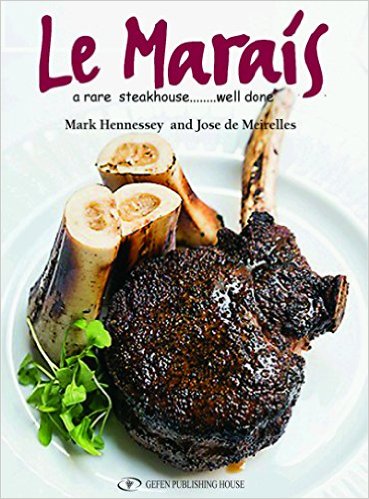 Before
ending my remarks, I must draw your attention to
the restaurant’s cookbook, Le Marais: A
Rare Steakhouse...Well Done by Hennessey and
Meirelles, which actually gives alternate recipes
for kosher and non-kosher preparation for many
dishes. It
is as fine a carnivore’s guide to great meat and
the proper way to cook it as any out there,
including a chapter on the individual cuts with
churlish comments about some, such as the tournedo
and pepper steak are “girly cuts” and the
exclamation of “Oy gevalt!” next to the
temperature “well done.”
Before
ending my remarks, I must draw your attention to
the restaurant’s cookbook, Le Marais: A
Rare Steakhouse...Well Done by Hennessey and
Meirelles, which actually gives alternate recipes
for kosher and non-kosher preparation for many
dishes. It
is as fine a carnivore’s guide to great meat and
the proper way to cook it as any out there,
including a chapter on the individual cuts with
churlish comments about some, such as the tournedo
and pepper steak are “girly cuts” and the
exclamation of “Oy gevalt!” next to the
temperature “well done.”
You get that sense of humor
throughout an evening at Le Marais. You go for
great food and great fun with friends. They
treat you nice.
Gotta end with
a joke:
Q: What did the waiter ask the group of Jewish
mothers?
A: "Is anything OK?"
Waiters at Le Marais are not
likely to get many complaints about anything.
❖❖❖
By John Mariani
THEY HAVE FOR THREE GENERATIONS
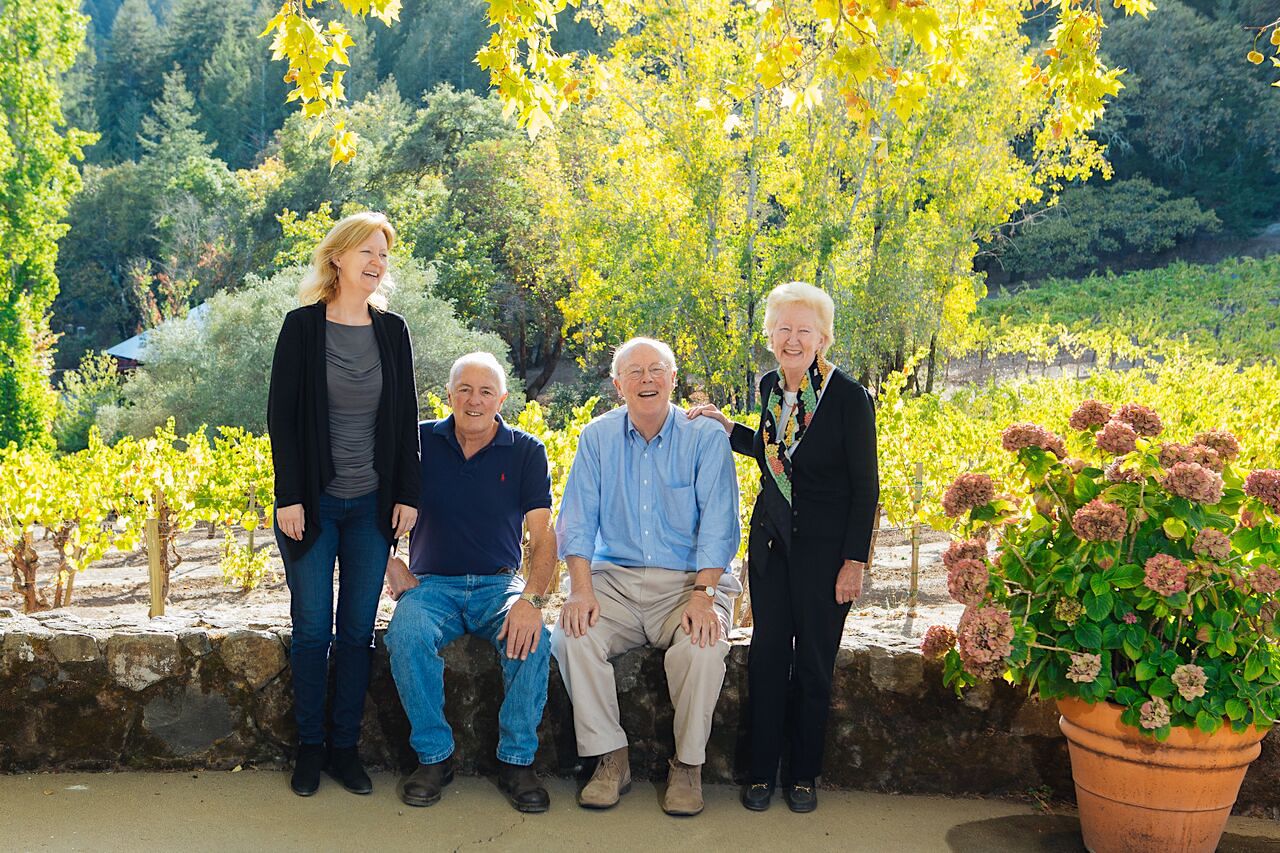
Despite a production
of only 1,000 cases each year, it is hardly a
compliment to call the chardonnay of Napa’s
Stony Hill winery a “cult wine,” which in the
overheated parlance of the wine media refers
to an outrageously expensive California wine
whose dubious reputation is based on a few
hyperbolic reviews and high score numbers that
cause a mad rush among well-heeled oenophiles
to buy up all they can in order to stock their
trophy case.
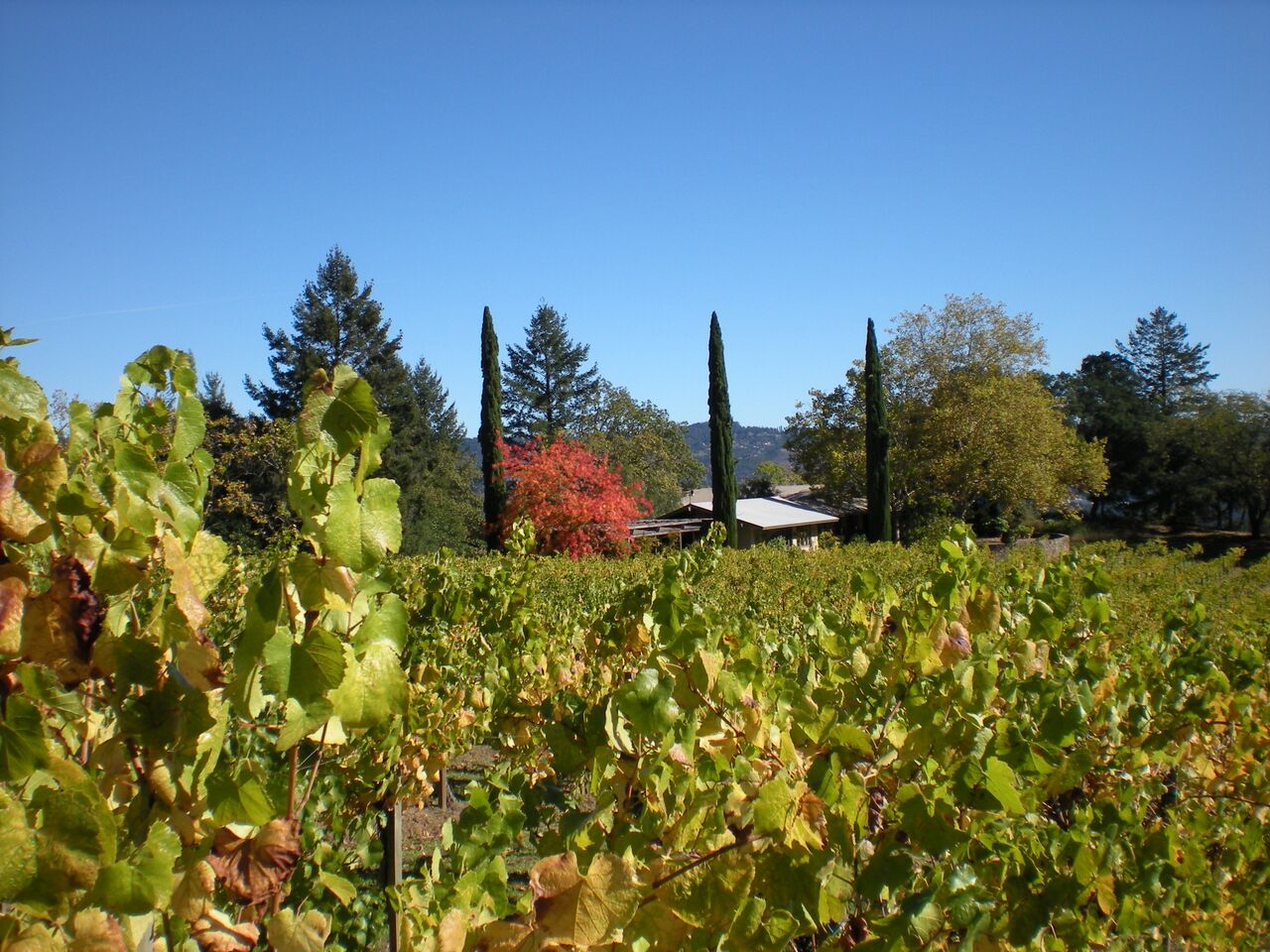 To be sure, Stony
Hill’s chardonnays are much sought after and
very well respected, not least because the
winery seems so stubborn about making them its
flagship bottling. (Stony Hill also makes about
400 cases of cabernet sauvignon, as well as
gewürztraminer, syrah, white riesling and
semillon de soleil.) More importantly, Stony
Hill’s chardonnays depart significantly from the
usual Napa Valley style of heavily oaked, high
alcohol wines tasting like buttered caramel. Stony
Hill’s are far more like Burgundian chardonnays
that aim for balance and finesse based on a
millennium of working with a varietal that can
be made into the finest Grand Crus as well as
cheap Chablis.
To be sure, Stony
Hill’s chardonnays are much sought after and
very well respected, not least because the
winery seems so stubborn about making them its
flagship bottling. (Stony Hill also makes about
400 cases of cabernet sauvignon, as well as
gewürztraminer, syrah, white riesling and
semillon de soleil.) More importantly, Stony
Hill’s chardonnays depart significantly from the
usual Napa Valley style of heavily oaked, high
alcohol wines tasting like buttered caramel. Stony
Hill’s are far more like Burgundian chardonnays
that aim for balance and finesse based on a
millennium of working with a varietal that can
be made into the finest Grand Crus as well as
cheap Chablis.
“I guess you could say we’re
just more stuck in our ways than dogmatic,”
Stony Hill’s president and marketing manager,
Sarah McCrea, told me over dinner in New York at
Union Square Café. “It’s a style choice of
others to make a high alcohol wine, and we don’t
want overripe fruit. We also age our chardonnay
in old barrels, which means they haven’t that
strong charred oak taste and are more neutral,
and our chardonnays do not go through malolactic
fermentation. We look for elegance in our wines,
not power.
We’ve just been doing what we’ve always
done for three generations of our family.”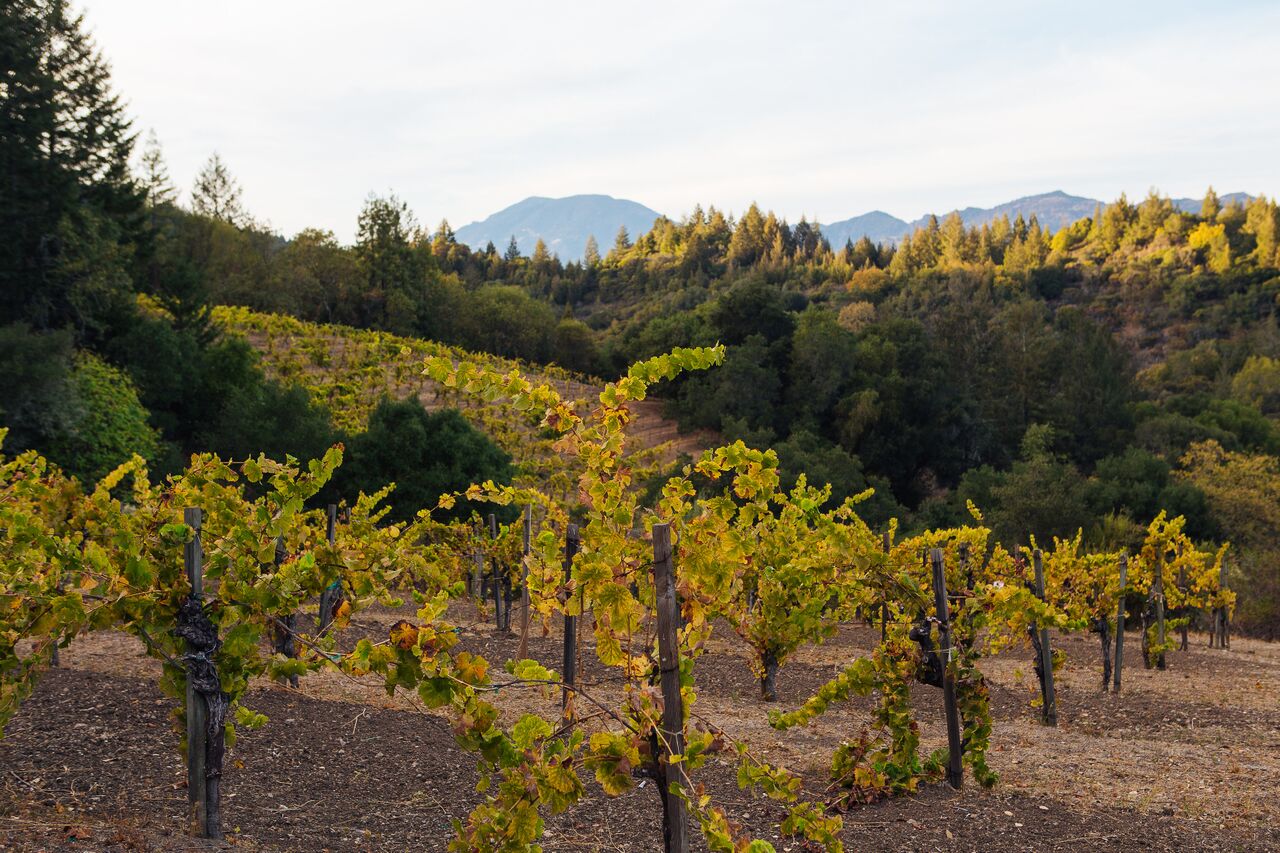
Back in 1943
advertising exec Fred McCrea and his wife,
Eleanor, bought a vineyard on a rugged hillside
of Spring Mountain and took wine courses at the
U. of California, determined to evoke their
favorite white Burgundies along with other
varietals to even out the vineyard. The first
harvest was in 1952, successfully selling only
through the mail. Upon Fred’s death in 1977, his
assistant and protégé, Mike Chelini, became
winemaker, now a 40-year veteran who is not
about to change his methods based on trends.
After Eleanor’s death in
1991, her son Peter, an exec at Chevron
Corporation, and daughter-in-law, Willinda,
assumed day-to-day management of the winery, and
in 2011, their daughter, Sarah, joined the
family business.
It was not her first choice of careers,
though she always knew she’d be involved in one
way or the other.
Sarah grew up in San Francisco but spent memorable
weekends and summers on Spring Mountain. She
later worked as a strategist for global brand
consulting firm Landor Associates and became an
in-house brand strategist for Nordstrom, then
for Starbucks, then as brand strategy and
marketing communications manager for Jamba
Juice. In
2010, when her father and mother spoke of
retiring, Sarah began working at the winery
part-time; three years later she was leading
operations, including the direct mail list,
national sales, and working closely with
Chelini. She
is married and has three step-children.
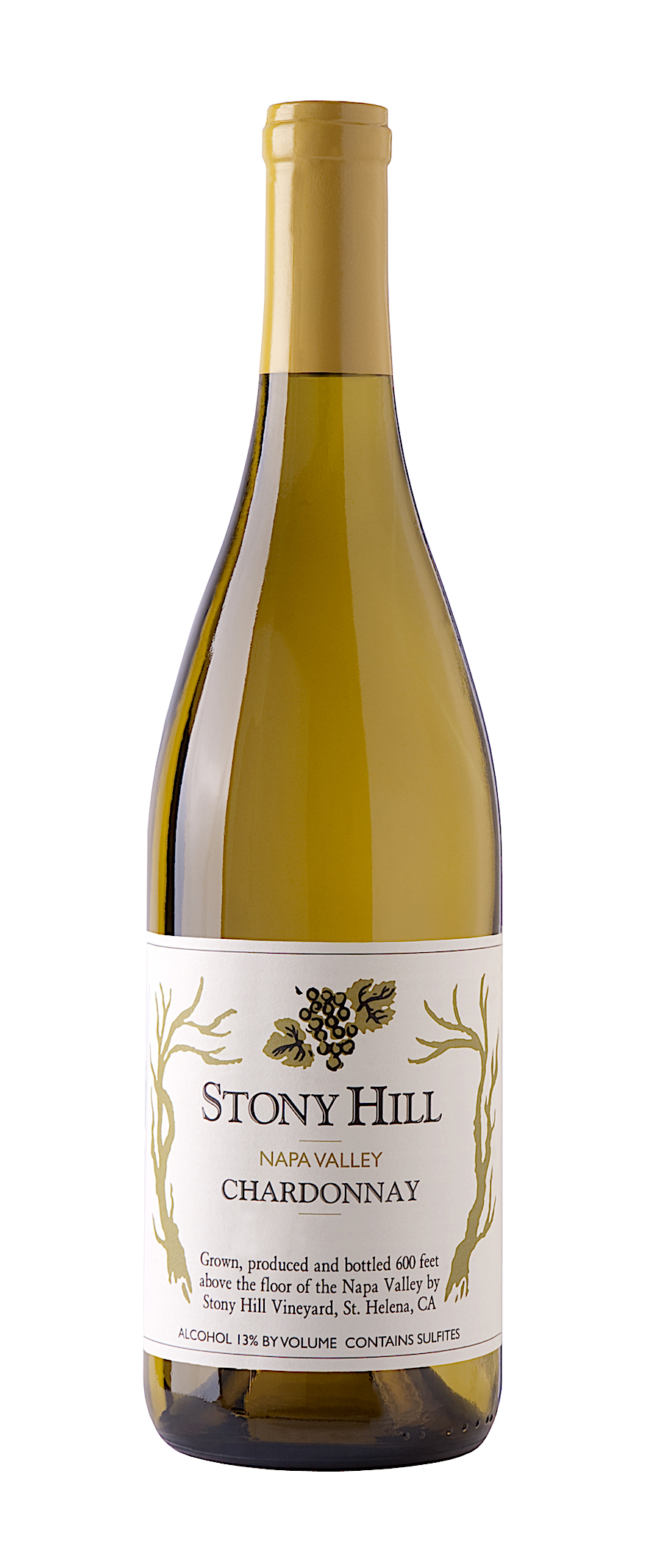 Now,
thanks to her marketing efforts, Stony Hill is
sold in 20 states, largely by mail order and in
restaurants, with only a few retail stores.
Now,
thanks to her marketing efforts, Stony Hill is
sold in 20 states, largely by mail order and in
restaurants, with only a few retail stores.
Stony Hill’s location in the
upper levels of rocky Spring Mountain takes
advantage of its cooler climate and its more
acidic soil, with shale bedrock. Although
immune to phylloxera, the vines suffered
terribly from the bacterial Pierce’s Disease,
for which there is no cure, and replanting has
been extensive, acre by acre.
Stony Hill’s chardonnays have
been justly famous for their longevity, not
unusual in the finest Burgundies but rare in
California, where the wines are made to be drunk
upon release.
“We seek to bring out the best fruit from
the vintage,” said McCrea, “to see what might
develop in five or six years. Oak
can just mask, even obliterate, that
development, and it’s why our wines taste so
fresh after so many years.”
Yet,
despite such renown and such small production,
McCrea says her family insists on keeping their
wines at reasonable prices, with most
vintages—even older ones, if you can find
them—around $42 and, for the exceptional 2009,
just $58.
The current 2012 vintage of cabernet
sauvignon is sold out, but other years run
around $60; Gewürztraminer, white Riesling and
the sweet passito-like semillon de soleil are
all $30.
I asked McCrea what she sees
for Stony Hill ten years in the future for a
winery with a long view of history.
“We just want to continue to
find ways to optimize what we do,” she said. “The winery has seen very few
changes over the decades and is still minimalist
by design, but we’re under
pressure to plant more cabernet, because you can
charge so much more for it. You
can’t even get a bank loan to plant the other
varietals we do.
But we’ve been doing it for three
generations, it’s a family business, and
everything’s worked out pretty well for us. If we
don’t have to change, we just won’t.”
She also sees the future of
fine wine with great optimism, saying,“The wine world is decidedly not
the same. If anything, it’s better—more people
are drinking wine than ever, and Americans are
developing a renewed understanding of what
Chardonnay truly is. All the more reason for us
to stay true to tradition and produce elegant,
age-worthy Chardonnay.”
 SOME PEOPLE GOT AN EXTRA
SOME PEOPLE GOT AN EXTRA
NIGHT'S
STAY OUT OF IT
At
the beginning of the winter season at the four-start luxury
hotel Romantik
Seehotel Jaegerwirt in Turrach, Austria, hackers
accessed the hotel’s IT system and shut
everything down, locking many of the 180 people were
staying at the hotel out of their rooms. The
hackers demanded the hotel pay $1,600 to re-open the
rooms, which the hotel did. "We had no other choice,” said managing
director Christoph Brandstaetter. “Neither police nor
insurance help you in this case.” Afterwards, Brandstaetter
promised to downgrade to old-fashioned keys in the
locks.
IN A STORY
ABOUT SWEDISH MEATBALLS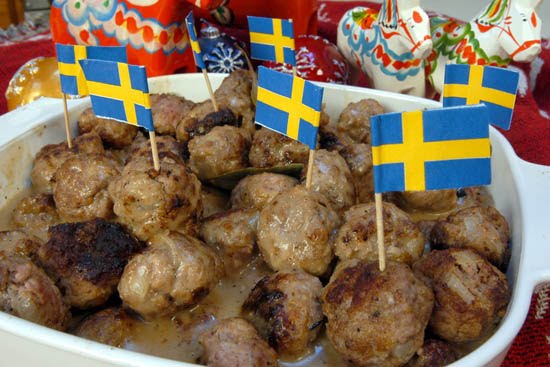
“Last
year,
I read a multivolume Proustian novel
about the life of the Norwegian writer Karl Ove
Knausgaard.”—Melissa Clark, “Swedish Meatballs,” NY Times
(1/6/17)
Sponsored by Banfi Vintners
ASKA
By John Fodera
TUSCAN VINES
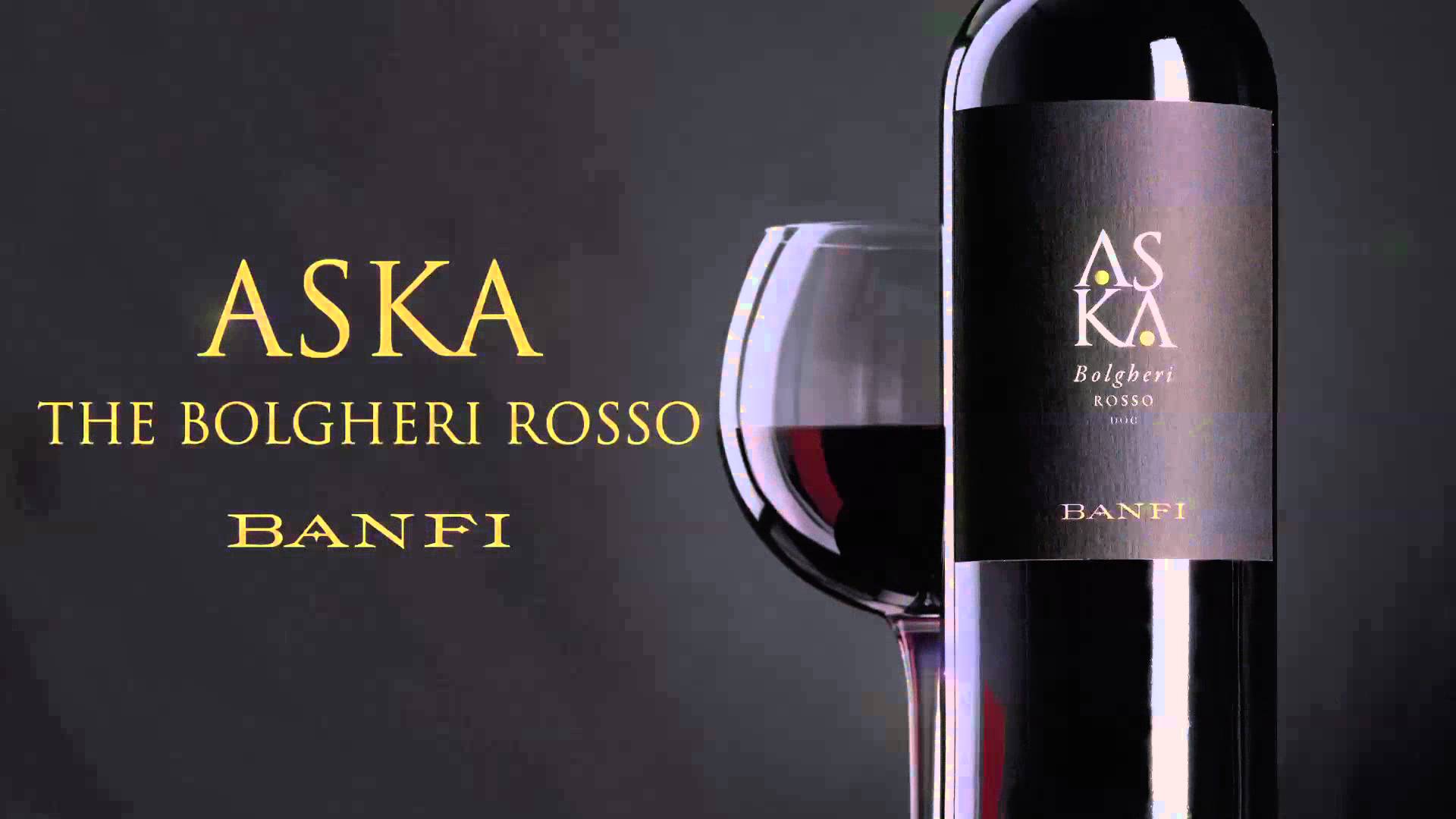 The story of coastal
Tuscany, the Maremma -- or Bolgheri as its
interchangeably referred to -- began with Sassicaia,
but it's not anywhere close to reaching its pinnacle. The region
has been a prime area for nurturing vitis vinifera
into compelling wine for decades.
The story of coastal
Tuscany, the Maremma -- or Bolgheri as its
interchangeably referred to -- began with Sassicaia,
but it's not anywhere close to reaching its pinnacle. The region
has been a prime area for nurturing vitis vinifera
into compelling wine for decades.
As I've written many times, the expansion to
Maremma of wineries based in central Tuscany and even
beyond to Piedmont, has taken on a frenetic pace. The
wild, untamed Maremma countryside, replete with water
buffalo, wild horses, and cowboys called butteri, has become
the perfect cradle for cultivation of classic
Bordelaise varieties.
Castello Banfi acquired 5 small hectares of
vineyards along the Tuscan coast with the aim of
producing a classic Cabernet-based wine that portrayed
the hallmarks of their elegant style. The result,
Aska. The
legend relates that
Aska is
the ancient Etruscan name for "wine vessel". These
ancient people, who called Tuscany home a millennia
ago, used Askas to
contain and transport wine and olive oil.
Aska was a touchstone for the Etruscans
because they believed that beneficial human emotions
were conferred by the Etruscan Gods of Sun and Moon. This legend
is symbolized by the two luminous discs on the wine's
label. First released in the 2012 vintage, Aska is
predominantly Cabernet Sauvignon with minor additions
of Cabernet Franc.
The vineyards giving the fruit are young, and
the debut release of Aska was elegant and
approachable. I
harbor the same sentiment for the subject of today's
review and look forward to following this vineyard as
it develops. We decanted the 2013 Banfi Aska for about
45 minutes before dinner, a simple pasta with earthy
flavors of wild boar and chanterelles.
In
the glass, the wine exudes aromas of crushed red
plums, cherries, soft vanilla and spice notes and a
faint hint of pine.
It's attractive to smell. On
the palate, the flavors echo the nose with primary red
plum flavors backed by soft wood and vanilla notes. The round,
elegant mouth feel trails off delicately and there is
little "bite" from the well-integrated tannins. This wine
stays fresh and lively and will be best enjoyed over
the next 3-4 years.
Aska is vinified in stainless steel and then
transferred to French barriques for 10 months
of refinement. A
brief bottle aging takes place before release.
Any of John Mariani's books below may be ordered from amazon.com.
 The
Hound in Heaven (21st Century Lion Books)
is a novella, and for anyone who loves dogs,
Christmas, romance, inspiration, even the supernatural, I
hope you'll find this to be a treasured favorite.
The story concerns how, after a New England teacher,
his wife and their two daughters adopt a stray puppy found
in their barn in northern Maine, their lives seem full of
promise. But when tragedy strikes, their wonderful dog
Lazarus and the spirit of Christmas are the only things
that may bring his master back from the edge of
despair.
The
Hound in Heaven (21st Century Lion Books)
is a novella, and for anyone who loves dogs,
Christmas, romance, inspiration, even the supernatural, I
hope you'll find this to be a treasured favorite.
The story concerns how, after a New England teacher,
his wife and their two daughters adopt a stray puppy found
in their barn in northern Maine, their lives seem full of
promise. But when tragedy strikes, their wonderful dog
Lazarus and the spirit of Christmas are the only things
that may bring his master back from the edge of
despair. WATCH THE VIDEO!
“What a huge surprise turn this story took! I was completely stunned! I truly enjoyed this book and its message.” – Actress Ali MacGraw
“He had me at Page One. The amount of heart, human insight, soul searching, and deft literary strength that John Mariani pours into this airtight novella is vertigo-inducing. Perhaps ‘wow’ would be the best comment.” – James Dalessandro, author of Bohemian Heart and 1906.
“John Mariani’s Hound in Heaven starts with a well-painted portrayal of an American family, along with the requisite dog. A surprise event flips the action of the novel and captures us for a voyage leading to a hopeful and heart-warming message. A page turning, one sitting read, it’s the perfect antidote for the winter and promotion of holiday celebration.” – Ann Pearlman, author of The Christmas Cookie Club and A Gift for my Sister.
“John Mariani’s concise, achingly beautiful novella pulls a literary rabbit out of a hat – a mash-up of the cosmic and the intimate, the tragic and the heart-warming – a Christmas tale for all ages, and all faiths. Read it to your children, read it to yourself… but read it. Early and often. Highly recommended.” – Jay Bonansinga, New York Times bestselling author of Pinkerton’s War, The Sinking of The Eastland, and The Walking Dead: The Road To Woodbury.
“Amazing things happen when you open your heart to an animal. The Hound in Heaven delivers a powerful story of healing that is forged in the spiritual relationship between a man and his best friend. The book brings a message of hope that can enrich our images of family, love, and loss.” – Dr. Barbara Royal, author of The Royal Treatment.
 |
The Encyclopedia of American Food and Drink by John F. Mariani (Bloomsbury USA, $35) Modesty forbids me to praise my own new book, but let me proudly say that it is an extensive revision of the 4th edition that appeared more than a decade ago, before locavores, molecular cuisine, modernist cuisine, the Food Network and so much more, now included. Word origins have been completely updated, as have per capita consumption and production stats. Most important, for the first time since publication in the 1980s, the book includes more than 100 biographies of Americans who have changed the way we cook, eat and drink -- from Fannie Farmer and Julia Child to Robert Mondavi and Thomas Keller. "This book is amazing! It has entries for everything from `abalone' to `zwieback,' plus more than 500 recipes for classic American dishes and drinks."--Devra First, The Boston Globe. "Much needed in any kitchen library."--Bon Appetit. |
"Eating Italian will never be the same after reading John Mariani's entertaining and savory gastronomical history of the cuisine of Italy and how it won over appetites worldwide. . . . This book is such a tasteful narrative that it will literally make you hungry for Italian food and arouse your appetite for gastronomical history."--Don Oldenburg, USA Today. "Italian
restaurants--some good, some glitzy--far
outnumber their French rivals. Many of
these establishments are zestfully described
in How Italian Food Conquered the World, an
entertaining and fact-filled chronicle by
food-and-wine correspondent John F.
Mariani."--Aram Bakshian Jr., Wall Street
Journal.
"Equal parts
history, sociology, gastronomy, and just
plain fun, How Italian Food Conquered the
World tells the captivating and delicious
story of the (let's face it) everybody's
favorite cuisine with clarity, verve and
more than one surprise."--Colman Andrews,
editorial director of The Daily
Meal.com. "A fantastic and fascinating
read, covering everything from the influence
of Venice's spice trade to the impact of
Italian immigrants in America and the
evolution of alta cucina. This book will
serve as a terrific resource to anyone
interested in the real story of Italian
food."--Mary Ann Esposito, host of PBS-TV's
Ciao
Italia. "John Mariani has written the
definitive history of how Italians won their
way into our hearts, minds, and
stomachs. It's a story of pleasure over
pomp and taste over technique."--Danny Meyer,
owner of NYC restaurants Union Square
Cafe, The Modern, and Maialino.
|
 |
 |
 |
 |
 |
 |
 |
 |
 Everett Potter's Travel Report:
Everett Potter's Travel Report: 
 Eating Las Vegas
JOHN CURTAS has been covering the Las Vegas
food and restaurant scene since 1995. He is
the co-author of EATING LAS VEGAS – The 50
Essential Restaurants (the fourth
edition of which will be published in early
2016), as well as the author of the Eating Las
Vegas web site: www.eatinglasvegas.
He can also be seen every Friday morning as
the “resident foodie” for Wake Up With the
Wagners on KSNV TV (NBC) Channel 3 in
Las Vegas.
Eating Las Vegas
JOHN CURTAS has been covering the Las Vegas
food and restaurant scene since 1995. He is
the co-author of EATING LAS VEGAS – The 50
Essential Restaurants (the fourth
edition of which will be published in early
2016), as well as the author of the Eating Las
Vegas web site: www.eatinglasvegas.
He can also be seen every Friday morning as
the “resident foodie” for Wake Up With the
Wagners on KSNV TV (NBC) Channel 3 in
Las Vegas.

MARIANI'S VIRTUAL GOURMET
NEWSLETTER is published weekly. Editor/Publisher: John
Mariani.
Editor: Walter Bagley. Contributing Writers: Christopher Mariani,
Robert Mariani, Misha Mariani, John A. Curtas, Geoff Kalish, Mort
Hochstein, and
Brian Freedman. Contributing Photographers: Galina
Dargery. Technical Advisor: Gerry McLoughlin.
To un-subscribe from this newsletter,click here.
© copyright John Mariani 2017

